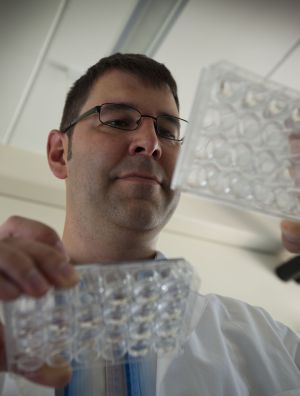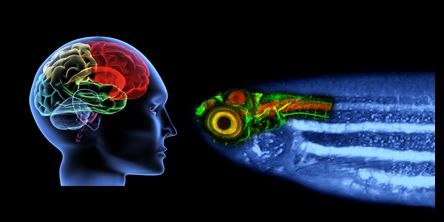The thalamus is the central translator in the brain: Specialized nerve cells (neurons) receive information from the sensory organs, process it, and transmit it deep into the brain. Researchers from the Institute of Toxicology and Genetics (ITG) of KIT have now identified the genetic factors Lhx2 and Lhx9 responsible for the development of these neurons. Their results contribute to understanding the development of the thalamus. In the long term, they are to help healing thalamic strokes.
With 100 billion nerve cells, the brain is the most complex organ in the human body. “We want to understand the development program behind,” says Dr. Steffen Scholpp from the ITG. “We want to find out how individual parts of the brain develop, this means, what makes precursor cells build a specialized area such as the thalamus.” Scholpp’s group at ITG studies the development of the thalamus. “It is the central interface between the brain and the outer world: Everything that is perceived via eyes, ears or the tactile sense has to pass the thalamus before it is routed to the cerebral cortex for further processing.”
In the long term, the scientists want to be able to heal damaged brain parts by a tissue replacement therapy. If, for example, brain tissue is damaged after an infarct, is the body is not able to regenerate this tissue. “Today, stroke is the most frequent cause of disability acquired at adult age and due to its central role, damage of the thalamus is very serious,” emphasizes Steffen Scholpp. “For this reason, we have to find a strategy to activate stem cells such that the damaged tissue can be replaced.” Recently, an important step was made by the scientists: By studying zebrafish, they identified Lhx2 and Lhx9, the factors controlling the development of neurons in the thalamus. “Without these factors, the thalamus would accommodate undifferentiated nerve cells only – this means, the precursory cells lack the information required for specialization,” explains the biologist. Analysis of brain development in zebrafish allows conclusions to be drawn with respect to the development in all vertebrates, including human. The results of the group are published in the current issue of the “PLoS Biology“ journal.

Dr. Steffen Scholpp. (Photo: ITG, KIT)
In the same study, Scholpp and his team identified another factor that acts as “adhesive” in the thalamus: The cell adhesion molecule Pcdh10b ensures development of the thalamus without mixing with the surrounding brain areas. If this factor is lacking, the neurons differentiate, but do not find their target destination. It is now the objective of the researchers to activate these factors in the cultivating dish (in vitro) in undifferentiated cells first for new thalamus tissue to form. In close cooperation with engineers, the biologists are already developing 2-dimensional cell culture systems. In January, they will start a 3D cell cultivation project. “KIT offers excellent opportunities: Parallel to our research, materials researchers work on the development of various biomaterials (biopolymers) which will be tested in the cultivation experiments”, says Scholpp.
Dr. Steffen Scholpp thinks that it will be possible to heal stroke patients in the future. “Of course, this will take some years. But it is our ultimate goal to take out quiescent stem cells from a stroke patient and to switch on the specific development biology program in these cells outside of the body. Finally, we plan to bring them back to the position of the damaged tissue. This would be real healing.”
Under the Emmy Noether program, the German Research Foundation (DFG) has granted funding in the amount of EUR 1.3 million to Dr. Steffen Scholpp for a duration of five years. The Emmy Noether program is designed to support young scientists in establishing an own working group. The team of Dr. Steffen Scholpp presently comprises one postdoctoral research fellow, three doctoral students, a technical employee, and two master students.
Being “The University in the Helmholtz Association”, KIT creates and imparts knowledge for the society and the environment. It is the objective to make significant contributions to the global challenges in the fields of energy, mobility, and information. For this, about 10,000 employees cooperate in a broad range of disciplines in natural sciences, engineering sciences, economics, and the humanities and social sciences. KIT prepares its 22,800 students for responsible tasks in society, industry, and science by offering research-based study programs. Innovation efforts at KIT build a bridge between important scientific findings and their application for the benefit of society, economic prosperity, and the preservation of our natural basis of life. KIT is one of the German universities of excellence.

